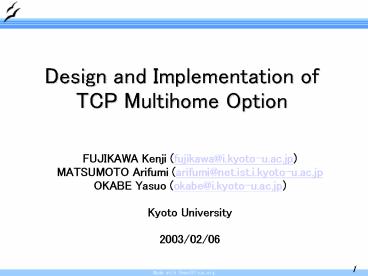Design and Implementation of - PowerPoint PPT Presentation
1 / 15
Title:
Design and Implementation of
Description:
Ingress Filtering in ISP. An apropriate src address is required for each next-hop ... Traverse ingress filter by trying all the source addresses. ... – PowerPoint PPT presentation
Number of Views:23
Avg rating:3.0/5.0
Title: Design and Implementation of
1
Design and Implementation of TCP Multihome Option
FUJIKAWA Kenji (fujikawa_at_i.kyoto-u.ac.jp) MATSUMOT
O Arifumi (arifumi_at_net.ist.i.kyoto-u.ac.jp OKABE
Yasuo (okabe_at_i.kyoto-u.ac.jp) Kyoto
University 2003/02/06
2
Backgrounds
- Internet connection using multiple lines
(multihoming) is becoming common - Reliable connection is required for a personal
use with multiple lines - Seamless connection is required without loss of
connection when moving - IPv6 multihoming is also required, as IPv6 is
promoted - The multihome method based on the current BGP has
problems - Routing table size becomes huge
- Cannot support site-level or host-level
multihoming - We propose End-to-end Multihoming
3
End-to-End Multihoming
- End nodes change the path in order to avoid
failure by themselves
2002330/64
133.69.66.2
L4 or upper layer support is needed for
detecting commucation failure
3ffe11/64
20011122/64
43.245.1.2
Highly reliable communication without depending
on routing (solving the current problems)
4
Barriers to E2E Multihoming
- Limitation from the current TCP/IP
- Only one pair of addresses can be used for one
connection - Addresses cannot be changed when the connection
is continuing - Ingress Filtering in ISP
- An apropriate src address is required for each
next-hop - Otherwise, the packet will be discarded by the
filtering - Enormous assets (applications, nodes)
- Relpacing all the nodes for the purpose of
multihoming is unrealistic - Rewriting all the applications is also
unrealistic - Just modify TCP on end nodes
5
Proposal of TCP Multihome Method
- Support at Transport layer (L4)
- Define a protocol and TCP multihome options
- Functions
- Address info. exchange
- Detecting comm. failure
- Changing a path
- Asymmetric path support
- Advantage
- Current applications can be applied without
rewriting - Independent of L3 protocols
- Can use multiple L3 protocols simultaneously
- Co-exists all the L3 mobility protocols
Application
L5
TCP-MH
UDP
L4
MIP
MIP6
LIN6
IPv4
IPv6
L3
6
Related Works
- L4 Model
- SCTP(Add-IP extension)
- No interoperability with TCP.
- Troel's TCP
- Uses IPv6's extension header
- IPv6 dependent
- TCP Migrate Option
- ECDH key agreement.
- Used up TCP option space
- vulnerable to syn-flood attack and other DoS
attacks.
- L3.5 Model
- MAST
- Idea of Layer3.5
- No interaction with layer 4
- No clear specification
- NOID/SHIM
- No interaction with layer 4
- Router support
- HIP
- No interaction with layer 4
- Yet to support Multi-home
- LIN6
- No Multi-Home support
7
Basic Protocol Design
- Simple and Minimum change to the existing TCP
- Defines several new TCP Options
- Not affect any other functions of TCP(flow
control, congestion avoidance) - Backward interoperability and fairness
- Rapid recovery from transmission failure
- After some RTOs, path(src-dst address pair)
changes. - Traverse ingress filter by trying all the source
addresses. - Protection for Redirection Attack, Session Hijack
and Syn-Flood Attack.
8
Protocol Behavior Overview
NodeA
NodeB
EST
EST
ADD
ADD
ADD
ADD
9
Packet Format
- TCP Option field size is up to 40 bytes!
- MH-Permitted Option
- Negotiates multi-home capability.
- Address Configuration Options
- MH-Add/Delete Option
- MH-Serial is incremented by one if its ack
returns. - Each hosts can have one outstanding MH-Serial.
- Address Configuration Ack. Options
- MH-Add/Non-Ack Option
- MH-Serial is copied from MH-Add/Delete Option.
10
Considerations -Path Switch-
- Path switches when
- Several times(should be 3) of RTOs(cwnd-gt0)
occurs. This typically takes about 10-20 sec. - ICMP Error is received. (temporary network
failure) - Path is discarded when
- RST is the first received packet from that path.
(the packet is probably from irrelevant host.
e.g. private address) - Path's address is deleted by either of nodes.
- When a path changes, window size is almost always
set to 1MSS because of RTOs.
Path Flapping Avoidance
11
Considerations -Security(1/2)-
- Redirection Attack
- Redirects traffic to third party for DoS attack.
- Targeted host can RST connection,
- so this seems not so serious.
- By introducing Return-Routablity
- check, this is easily prevented but not yet
included.
T
3) Data
B
2) Ack
1) Add(T)
A
NodeB(adr1)
NodeB(adr2)
NodeA
Add(adr2)
Add(adr2)
Confirm
Con-Ack
Add-Ack
RST
12
Considerations -Security(2/2)-
- Session Hijack
- protected by strict MH-Serial number management.
- Unexpected Serial number means being attacked and
session itself should soon be canceled. - This mechanism, however, doesn't have any
protection against Man-In-the-Middle attack. This
is also true for the existing TCP. - The difference is that MITM host can fetch a
session to anywhere else. (This degrades TCP
security ?)
MIM
2) Ack
1) Add
1) Add
B
2) Ack
A
(and it's possible to use TCP ISN as a shared
secret but not perfect)
13
TCP-MH Status
- Basic Specification and its implementation
Completed - On NetBSD1.6.1
- Future Works
- Return-Routability Check
- NAT/NAPT Traversal
- Related Works
- MIP/MIP6 multiple home-address support
- Interaction with Routing Table (Source Address
Selection)
14
Application to usual use
- A TCP-MH-support host runs SOCKS/HTTP Proxy
(SOCKS box) - E2E multihoming is available beyond the SOCKS box
E2E-MH
E2E-MHsupport
TCP
E2E-MH support SOCKS/HTTP Proxy
Hosts without TCP-MH functions also receive
benefits of TCP
E2E-MH unsupported
15
Concluding Remarks
- Propose TCP Multihoming protocol and TCP options
for it - Implemented on NetBSD 1.6.1
- TCP-MH support SOCKS box is available for usual
use - Future Work,
- Evaluate on real environments
- Propose TCP-MH in IETF.

